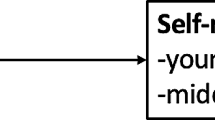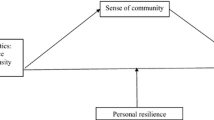Abstract
To examine the relationships between perceptions of neighborhood environment, sense of community, and self-rated heath, we recruited 1798 people aged 60 years and older living in Hong Kong. With reference to the checklist of the essential features of age-friendly cities developed by the World Health Organization, perceptions of neighborhood environment were assessed using a questionnaire covering physical and social environmental domains, which mapped onto “outdoor spaces and buildings,” “transportation,” “housing,” “social participation,” “respect and social inclusion,” “civic participation and employment,” “communication and information,” and “community support and health services.” Sense of community was measured by the Brief Sense of Community Scale. Self-rated health was assessed by a single question. The relationships between these measures were analyzed using partial correlations, multivariate regression models, and path analyses. The mean age of the participants was 71.7 years; of which 54.3% were women. In multivariate regression models, perceived neighborhood environments were positively associated with sense of community and self-rated health. Among the domains of perceived neighborhood environment, “transportation” and “respect and social inclusion” were the physical and the social environmental domains most strongly associated with sense of community, respectively. In addition, sense of community accounted for part of the relationship between perceived neighborhood environments and self-rated health. The results of this study support the importance of perceived neighborhood environments for the sense that older person has of one’s community, and self-rated health of older people which may be enhanced through the improvement of neighborhood environments.


Similar content being viewed by others
References
The World Health Organization. Global age-friendly cities: a guide. Geneva, Switzerland; 2007.
Gao JL, Fu H, Li J, Jia YN. Association between social and built environments and leisure-time physical activity among Chinese older adults—a multilevel analysis. BMC Public Health. 2015;15:317.
Barnett A, Cerin E, Zhang CJP, et al. Associations between the neighbourhood environment characteristics and physical activity in older adults with specific types of chronic conditions: the ALECS cross-sectional study. Int J Behav Nutr Phys Act. 2016;13:53.
Sallis JF, Cerin E, Conway TL, et al. Physical activity in relation to urban environments in 14 cities worldwide: a cross-sectional study. Lancet. 2016;387(10034):2207–17.
Wen M, Hawkley LC, Cacioppo JT. Objective and perceived neighborhood environment, individual SES and psychosocial factors, and self-rated health: an analysis of older adults in Cook County, Illinois. Soc Sci Med. 2006;63(10):2575–90.
Sarason SB. The psychological sense of community: prospects for a community psychology. San Francisco: Jossey-Bass; 1974.
Mcmillan DW, Chavis DM. Sense of community—a definition and theory. J Community Psychol. 1986;14(1):6–23.
Talo C, Mannarini T, Rochira A. Sense of community and community participation: a meta-analytic review. Soc Indic Res. 2014;117(1):1–28.
Chavis DM, Wandersman A. Sense of Community in the Urban-Environment—a catalyst for participation and community-development. Am J Community Psychol. 1990;18(1):55–81.
Cramm JM, Nieboer AP. Relationships between frailty, neighborhood security, social cohesion and sense of belonging among community-dwelling older people. Geriatr Gerontol Int. 2013;13(3):759–63.
van Hooijdonk C, Droomers M, Deerenberg IM, Mackenbach JP, Kunst AE. The diversity in associations between community social capital and health per health outcome, population group and location studied. Int J Epidemiol. 2008;37(6):1384–92.
Prezza M, Amici M, Roberti T, Tedeschi G. Sense of community referred to the whole town: its relations with neighboring, loneliness, life satisfaction, and area of residence. J Community Psychol. 2001;29(1):29–52.
Davidson WB, Cotter PR. The relationship between sense of community and subjective well-being: a first look. J Community Psychol. 1991;19:246–53.
Young AF, Russell A, Powers JR. The sense of belonging to a neighbourhood: can it be measured and is it related to health and well being in older women? Soc Sci Med. 2004;59(12):2627–37.
Wiles JL, Allen RES, Palmer AJ, Hayman KJ, Keeling S, Kerse N. Older people and their social spaces: a study of well-being and attachment to place in Aotearoa New Zealand. Soc Sci Med. 2009;68(4):664–71.
Aiello A, Ardone RG, Scopelliti M. Neighbourhood planning improvement: physical attributes, cognitive and affective evaluation and activities in two neighbourhoods in Rome. Eval Program Plann. 2010;33(3):264–75.
McLaren S, Jude B, Hopes L, Sherritt T. Sense of belonging, stress and depression in rural-urban communities. International Journal of Rural Psychology. 2001;2(7):1–12.
Belue R, Taylor-Richardson KD, Lin JM, McClellan L, Hargreaves MK. Racial disparities in sense of community and health status: implications in community-based participatory interventions targeting chronic disease in African Americans. J Ambul Care Manage. 2006;29(2):112–24.
Davidson WB, Cotter PR, Stovall JG. Social predispositions for the development of sense of community. Psychol Rep. 1991;68(3):817–8.
Li WW, Hodgetts D, Ho E. Gardens, transitions and identity reconstruction among older Chinese immigrants to New Zealand. J Health Psychol. 2010;15(5):786–96.
James RN, Carswell AT, Sweaney AL. Sources of discontent residential satisfaction of tenants from an internet ratings site. Environ Behav. 2009;41(1):43–59.
Lu M. Determinants of residential satisfaction: ordered logit vs. regression models. Growth Change. 1999;30(2):264–87.
Obst P, Smith SG, Zinkiewicz L. An exploration of sense of community, part 3: dimensions and predictors of psychological sense of community in geographical communities. J Community Psychol. 2002;30(1):119–33.
Prezza M, Costantini S. Sense of community and life satisfaction: investigation in three different territorial contexts. J Community Appl Soc Psychol. 1998;8(3):181–94.
Atkinson R, Blandy S. Introduction: international perspectives on the new enclavism and the rise of gated communities. Hous Stud. 2005;20(2):177–86.
Zhang H, Shyng J. Study on the relationship between dwelling characteristics and residential function satisfaction—collective housing as examples. Journal of Architecture (Taiwan). 2004;47:89–106.
French S, Wood L, Foster SA, Giles-Corti B, Frank L, Learnihan V. Sense of community and its association with the neighborhood built environment. Environ Behav. 2014;46(6):677–97.
Wood L, Frank LD, Giles-Corti B. Sense of community and its relationship with walking and neighborhood design. Soc Sci Med. 2010;70(9):1381–90.
Chipuer HM, Pretty GMH. A review of the sense of community index: current uses, factor structure, reliability, and further development. J Community Psychol. 1999;27(6):643–58.
Hou J, Sung N. Urban residents’ sense of community in Taichung li-Ming community. Journal of Architecture (Taiwan). 1998;24:51–65.
Mak WW, Cheung RY, Law LS. Sense of community in Hong Kong: relations with community-level characteristics and residents’ well-being. Am J Community Psychol. 2009;44(1–2):80–92.
Li LH. The physical environment and a “sense of neighborhood” in residential communities in Hong Kong. Prop Manag. 2008;26(1):7–24.
Grundy E, Sloggett A. Health inequalities in the older population: the role of personal capital, social resources and socio-economic circumstances. Soc Sci Med. 2003;56(5):935–47.
Chau PH, Gusmano MK, Cheng J, Cheung SH, Woo J. Social vulnerability index for the older people—Hong Kong and New York City as examples. J Urban Health: Bull N Y Acad Med. 2014;91(6):1048–64.
Wong M, Yu R, Woo J. Effects of perceived neighbourhood environments on self-rated health among community-dwelling older Chinese. Int J Environ Res Public Health. 2017;14(6).
The World Health Organization. Checklist of essential features of age-friendly cities. Geneva, Switzerland 2007.
Huang YN, Wong H. Impacts of sense of community and satisfaction with governmental recovery on psychological status of the Wenchuan earthquake survivors. Soc Indic Res. 2014;117(2):421–36.
Tang F, Chi I, Xu L, Dong X. Exploring relationships of psychological sense of community with self-rated health and depressive symptoms among older Chinese Americans. Gerontol Geriatr Med. 2018;4:2333721418778183.
Fiorillo D, Lavadera GL, Nappo N. Social participation and self-rated psychological health: a longitudinal study on BHPS. SSM Popul Health. 2017;3:266–74.
Krause N. Providing emotional support to others, self-esteem, and self-rated health. Arch Gerontol Geriatr. 2016;65:183–91.
Moustafa YM. Design and neighborhood sense of community: an integrative and cross-culturally valid theoretical framework. ArchNet-IJAR. 2009;3(1):71–91.
Zhang Z, Zhang J. Perceived residential environment of neighbhorhood and subjective well-being among the elderly in China: a mediating role of sense of community. J Environ Psychol. 2017;51:82–94.
Lund H. Pedestrian environments and sense of community. J Plan Educ Res. 2002;21(3):301–12.
Brown SC, Mason CA, Lombard JL, et al. The relationship of built environment to perceived social support and psychological distress in Hispanic elders: the role of “eyes on the street.”. J Gerontol Ser B Psychol Sci Soc Sci. 2009;64(2):234–46.
CUHK Jockey Club Institute of Ageing. Report on agewatch index for Hong Kong 2015. The Hong Kong Jockey Club. Hong Kong, China; 2017.
Ronzi S, Orton L, Pope D, Valtorta NK, Bruce NG. What is the impact on health and wellbeing of interventions that foster respect and social inclusion in community-residing older adults? A systematic review of quantitative and qualitative studies. Syst Rev. 2018;7(1):26.
Acknowledgements
The Jockey Club Age‐friendly City Project was supported by the Hong Kong Jockey Club Charities Trust. The authors thank the investigators, research associates and team members for the design, collection, collation, validation and management of the data used in this article. Further appreciation is extended to the participants for their contributions to the study.
Author information
Authors and Affiliations
Corresponding author
Additional information
Publisher’s Note
Springer Nature remains neutral with regard to jurisdictional claims in published maps and institutional affiliations.
Electronic Supplementary Material
ESM 1
(DOCX 14 kb)
Rights and permissions
About this article
Cite this article
Yu, R., Wong, M. & Woo, J. Perceptions of Neighborhood Environment, Sense of Community, and Self-Rated Health: an Age-Friendly City Project in Hong Kong. J Urban Health 96, 276–288 (2019). https://doi.org/10.1007/s11524-018-00331-3
Published:
Issue Date:
DOI: https://doi.org/10.1007/s11524-018-00331-3




